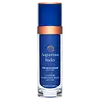Augustinus Bader The Rich Cream Versus Victoria Beckham Beauty Victoria Beckham By Augustinus Bader Cell Rejuvenating Priming Moisturizer
What's inside
What's inside
 Key Ingredients
Key Ingredients

 Benefits
Benefits

 Concerns
Concerns

 Ingredients Side-by-side
Ingredients Side-by-side

Water
Skin ConditioningCoco-Caprylate/Caprate
EmollientHelianthus Annuus Seed Oil
EmollientSqualane
EmollientGlycerin
HumectantArgania Spinosa Kernel Oil
EmollientEthyl Oleate
EmollientPersea Gratissima Oil
Skin ConditioningPolyglyceryl-4 Oleate
EmulsifyingMagnesium Sulfate
Oenothera Biennis Oil
EmollientPanthenol
Skin ConditioningPolyglyceryl-6 Oleate
EmulsifyingZinc PCA
HumectantPolyhydroxystearic Acid
EmulsifyingButylene Glycol
HumectantButyrospermum Parkii Butter
Skin ConditioningPotassium Sorbate
PreservativeSodium Benzoate
MaskingTocopherol
AntioxidantSodium Hyaluronate
HumectantHydrolyzed Rice Protein
Skin ConditioningMaltodextrin
AbsorbentCitric Acid
BufferingCamellia Sinensis Leaf Extract
AntimicrobialHydrogenated Lecithin
EmulsifyingTocopheryl Acetate
AntioxidantXanthan Gum
EmulsifyingAlanyl Glutamine
HumectantArginine
MaskingOligopeptide-177
Phenylalanine
MaskingSisymbrium Irio Seed Oil
MaskingSodium Chloride
MaskingDextran
Palmitoyl Tripeptide-8
Skin ConditioningWater, Coco-Caprylate/Caprate, Helianthus Annuus Seed Oil, Squalane, Glycerin, Argania Spinosa Kernel Oil, Ethyl Oleate, Persea Gratissima Oil, Polyglyceryl-4 Oleate, Magnesium Sulfate, Oenothera Biennis Oil, Panthenol, Polyglyceryl-6 Oleate, Zinc PCA, Polyhydroxystearic Acid, Butylene Glycol, Butyrospermum Parkii Butter, Potassium Sorbate, Sodium Benzoate, Tocopherol, Sodium Hyaluronate, Hydrolyzed Rice Protein, Maltodextrin, Citric Acid, Camellia Sinensis Leaf Extract, Hydrogenated Lecithin, Tocopheryl Acetate, Xanthan Gum, Alanyl Glutamine, Arginine, Oligopeptide-177, Phenylalanine, Sisymbrium Irio Seed Oil, Sodium Chloride, Dextran, Palmitoyl Tripeptide-8
Water
Skin ConditioningGlycerin
HumectantTriethylhexanoin
MaskingEthylhexyl Polyhydroxystearate
EmollientIsostearyl Isostearate
EmollientSaccharomyces/Xylinum/Black Tea Ferment
Skin Conditioning1,2-Hexanediol
Skin ConditioningOctyldodecyl Myristate
EmollientPersea Gratissima Oil
Skin ConditioningSilica
AbrasiveSodium Acrylates Copolymer
CI 77891
Cosmetic ColorantPotassium Cetyl Phosphate
EmulsifyingSodium Hyaluronate
HumectantPapain
Skin ConditioningSynthetic Fluorphlogopite
Chlorella Vulgaris Extract
Skin ConditioningLecithin
EmollientSodium Polyacrylate
AbsorbentPanthenol
Skin ConditioningCaprylic/Capric Triglyceride
MaskingCitric Acid
BufferingCetyl Palmitate
EmollientSorbitan Stearate
EmulsifyingTocopherol
AntioxidantSodium Hydroxide
BufferingCaprylyl Glycol
EmollientCarbomer
Emulsion StabilisingN-Hydroxysuccinimide
Skin ConditioningPropylene Glycol
HumectantSodium Benzoate
MaskingTin Oxide
AbrasiveAlgin
MaskingO-Cymen-5-Ol
AntimicrobialPolysorbate 80
EmulsifyingPotassium Sorbate
PreservativeHydrogenated Lecithin
EmulsifyingPalmitoyl Tetrapeptide-10
Skin ConditioningWater, Glycerin, Triethylhexanoin, Ethylhexyl Polyhydroxystearate, Isostearyl Isostearate, Saccharomyces/Xylinum/Black Tea Ferment, 1,2-Hexanediol, Octyldodecyl Myristate, Persea Gratissima Oil, Silica, Sodium Acrylates Copolymer, CI 77891, Potassium Cetyl Phosphate, Sodium Hyaluronate, Papain, Synthetic Fluorphlogopite, Chlorella Vulgaris Extract, Lecithin, Sodium Polyacrylate, Panthenol, Caprylic/Capric Triglyceride, Citric Acid, Cetyl Palmitate, Sorbitan Stearate, Tocopherol, Sodium Hydroxide, Caprylyl Glycol, Carbomer, N-Hydroxysuccinimide, Propylene Glycol, Sodium Benzoate, Tin Oxide, Algin, O-Cymen-5-Ol, Polysorbate 80, Potassium Sorbate, Hydrogenated Lecithin, Palmitoyl Tetrapeptide-10
 Reviews
Reviews

Ingredients Explained
These ingredients are found in both products.
Ingredients higher up in an ingredient list are typically present in a larger amount.
Citric Acid is an alpha hydroxy acid (AHA) naturally found in citrus fruits like oranges, lemons, and limes.
Like other AHAs, citric acid can exfoliate skin by breaking down the bonds that hold dead skin cells together. This helps reveal smoother and brighter skin underneath.
However, this exfoliating effect only happens at high concentrations (20%) which can be hard to find in cosmetic products.
Due to this, citric acid is usually included in small amounts as a pH adjuster. This helps keep products slightly more acidic and compatible with skin's natural pH.
In skincare formulas, citric acid can:
While it can provide some skin benefits, research shows lactic acid and glycolic acid are generally more effective and less irritating exfoliants.
Most citric acid used in skincare today is made by fermenting sugars (usually from molasses). This synthetic version is identical to the natural citrus form but easier to stabilize and use in formulations.
Read more about some other popular AHA's here:
Learn more about Citric AcidGlycerin is already naturally found in your skin. It helps moisturize and protect your skin.
A study from 2016 found glycerin to be more effective as a humectant than AHAs and hyaluronic acid.
As a humectant, it helps the skin stay hydrated by pulling moisture to your skin. The low molecular weight of glycerin allows it to pull moisture into the deeper layers of your skin.
Hydrated skin improves your skin barrier; Your skin barrier helps protect against irritants and bacteria.
Glycerin has also been found to have antimicrobial and antiviral properties. Due to these properties, glycerin is often used in wound and burn treatments.
In cosmetics, glycerin is usually derived from plants such as soybean or palm. However, it can also be sourced from animals, such as tallow or animal fat.
This ingredient is organic, colorless, odorless, and non-toxic.
Glycerin is the name for this ingredient in American English. British English uses Glycerol/Glycerine.
Learn more about GlycerinHydrogenated Lecithin is created from the hydrogenation of lecithin (a group of phospholipids). Hydrogenation is a chemical reaction between hydrogen and another element.
This ingredient is an emollient and emulsifier. As an emollient, it helps soften skin by trapping moisture within. As an emulsifier, it prevents oil and water ingredients from separating.
Panthenol is a common ingredient that helps hydrate and soothe the skin. It is found naturally in our skin and hair.
There are two forms of panthenol: D and L.
D-panthenol is also known as dexpanthenol. Most cosmetics use dexpanthenol or a mixture of D and L-panthenol.
Panthenol is famous due to its ability to go deeper into the skin's layers. Using this ingredient has numerous pros (and no cons):
Like hyaluronic acid, panthenol is a humectant. Humectants are able to bind and hold large amounts of water to keep skin hydrated.
This ingredient works well for wound healing. It works by increasing tissue in the wound and helps close open wounds.
Once oxidized, panthenol converts to pantothenic acid. Panthothenic acid is found in all living cells.
This ingredient is also referred to as pro-vitamin B5.
Learn more about PanthenolPersea Gratissima Oil is also known as avocado oil.
Avocado Oil has antioxidant properties. It is mostly made up of the glycerides of fatty acids. About 67% of these fatty acids is made up of oleic acid. Palmitic acid and linoleic acid are also present.
These fatty acids help hydrate and soften the skin. It may increase collagen content in the skin. Collagen helps keep your skin plump and firm. This ingredient helps reduce inflammation and has not shown to clog pores.
This ingredient may not be fungal-acne safe due to its high fatty acid content.
Avocados also have B vitamins, vitamin K, vitamin C, vitamin E, and potassium.
Learn more about Persea Gratissima OilPotassium Sorbate is a preservative used to prevent yeast and mold in products. It is commonly found in both cosmetic and food products.
This ingredient comes from potassium salt derived from sorbic acid. Sorbic acid is a natural antibiotic and effective against fungus.
Both potassium sorbate and sorbic acid can be found in baked goods, cheeses, dried meats, dried fruit, ice cream, pickles, wine, yogurt, and more.
You'll often find this ingredient used with other preservatives.
Learn more about Potassium SorbateSodium Benzoate is a preservative. It's used in both cosmetic and food products to inhibit the growth of mold and bacteria. It is typically produced synthetically.
Both the US FDA and EU Health Committee have approved the use of sodium benzoate. In the US, levels of 0.1% (of the total product) are allowed.
Sodium benzoate works as a preservative by inhibiting the growth of bacteria inside of cells. It prevents the cell from fermenting a type of sugar using an enzyme called phosphofructokinase.
It is the salt of benzoic acid. Foods containing sodium benzoate include soda, salad dressings, condiments, fruit juices, wines, and snack foods.
Studies for using ascorbic acid and sodium benzoate in cosmetics are lacking, especially in skincare routines with multiple steps.
We always recommend speaking with a professional, such as a dermatologist, if you have any concerns.
Learn more about Sodium BenzoateSodium Hyaluronate is hyaluronic acid's salt form. It is commonly derived from the sodium salt of hyaluronic acid.
Like hyaluronic acid, it is great at holding water and acts as a humectant. This makes it a great skin hydrating ingredient.
Sodium Hyaluronate is naturally occurring in our bodies and is mostly found in eye fluid and joints.
These are some other common types of Hyaluronic Acid:
Learn more about Sodium HyaluronateTocopherol (also known as Vitamin E) is a common antioxidant used to help protect the skin from free-radicals and strengthen the skin barrier. It's also fat soluble - this means our skin is great at absorbing it.
Vitamin E also helps keep your natural skin lipids healthy. Your lipid skin barrier naturally consists of lipids, ceramides, and fatty acids. Vitamin E offers extra protection for your skin’s lipid barrier, keeping your skin healthy and nourished.
Another benefit is a bit of UV protection. Vitamin E helps reduce the damage caused by UVB rays. (It should not replace your sunscreen). Combining it with Vitamin C can decrease sunburned cells and hyperpigmentation after UV exposure.
You might have noticed Vitamin E + C often paired together. This is because it is great at stabilizing Vitamin C. Using the two together helps increase the effectiveness of both ingredients.
There are often claims that Vitamin E can reduce/prevent scarring, but these claims haven't been confirmed by scientific research.
Learn more about TocopherolWater. It's the most common cosmetic ingredient of all. You'll usually see it at the top of ingredient lists, meaning that it makes up the largest part of the product.
So why is it so popular? Water most often acts as a solvent - this means that it helps dissolve other ingredients into the formulation.
You'll also recognize water as that liquid we all need to stay alive. If you see this, drink a glass of water. Stay hydrated!
Learn more about Water